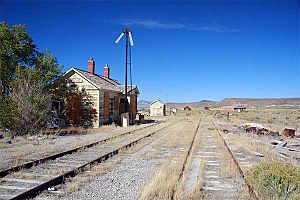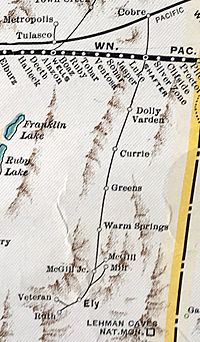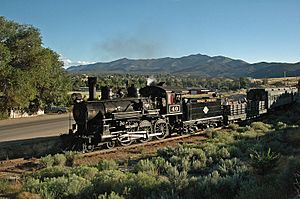Nevada Northern Railway facts for kids
| Overview | |||
|---|---|---|---|
| Headquarters | Ely, Nevada | ||
| Reporting mark | NN | ||
| Locale | Nevada | ||
| Dates of operation | 1905–1983 | ||
| Technical | |||
| Track gauge | 4 ft 8 1⁄2 in (1,435 mm) standard gauge | ||
|
|||
The Nevada Northern Railway was a special train line in Nevada. It was built mainly to reach a big area where copper was found. This railway was built between 1905 and 1906. It stretched about 140 miles (225 km) north from Ely. It connected with other major train lines like the Western Pacific Railroad and Southern Pacific Railroad. In 1967, the Nevada Northern carried a lot of goods, showing how important it was.
Contents
History of the Nevada Northern Railway

The Nevada Northern Railway started because a lot of copper was found near Ely in the early 1900s. A man named Mark L. Requa bought two of the biggest mines there in 1902. He then created the White Pine Copper Company.
It quickly became clear that trains were needed to move the copper from these faraway mines. The best way to build a train line was to go north from Ely. It would connect with the Southern Pacific train line near Wells.
More copper mines in the Ely area joined together in 1904. They formed the Nevada Consolidated Copper Company. The Nevada Northern Railway company was officially started on June 1, 1905. Its job was to build a train line connecting the mines and a copper processing plant to the main train network.
The Utah Construction Company began building the new railway on September 11, 1905. They started at Cobre, where the Nevada Northern would meet the Southern Pacific line. They built the tracks heading south. The line was finished a year later.
Everyone celebrated the railway's completion in Ely for two days. On September 29, 1906, called Railroad Day, Mark Requa drove the last spike. This special spike was made of local copper. A big dance party was even held inside the Northern building, which was still being built.
Building the Ore Line
More tracks were built near Ely between 1907 and 1908. These tracks were called the "Ore Line." They were made to serve the local mining industry. One part of the Ore Line went around Ely to the north. It continued west up Robinson Canyon to the copper mines at Ruth.
East of Ely, another part of the Ore Line was built. This was called the "Hiline." It led to Nevada Consolidated's new copper processing plant, called a smelter, and a concentrator at McGill. The Ore Line quickly became the busiest part of the Nevada Northern. Dozens of trains carrying copper ore traveled on it every day.
Life of the Railway
The main job of the Nevada Northern was to carry copper ore and products. It also carried other goods. The railway ran a daily passenger train between East Ely and Cobre until 1941. Local trains also ran from Ely to Ruth and McGill. These trains helped mine workers and others get around. Special school trains even took students to White Pine High School in central Ely.
In the 1920s and 1930s, the Kennecott Copper Corporation took control of Nevada Consolidated. In 1942, Nevada Consolidated officially joined Kennecott. This made the Nevada Northern a part of Kennecott.
Kennecott closed its mines near Ruth in May 1978. This happened because there wasn't as much copper left, and copper prices were low. This meant the ore trains between Ruth and the McGill smelter stopped running. The smelter itself closed on June 20, 1983. The Nevada Northern Railway stopped all its operations right after that.
The Nevada Northern Railway Today
Starting in 1986, Kennecott gave the entire Ore Line to a non-profit group. This group was the White Pine Historical Railroad Foundation. They also received the railway's train yard and repair shops in East Ely. Today, this group runs the property as the Nevada Northern Railway Museum. They operate a heritage railroad on this part of the old Nevada Northern line.
You can now take special train rides between Ely, Ruth, and McGill. These rides use old train cars pulled by historic steam and diesel locomotives. It's a great way to experience what train travel was like long ago!
In April 2006, the Nevada's National Historic Landmarks Committee decided to nominate the East Ely shops complex as a National Historic Landmark. This means it's a very important historical place. The National Park Service approved this nomination on September 27, 2006.
Most of the Nevada Northern line has been unused since 1983. In 1987, the Los Angeles Department of Water and Power bought the line between Cobre and East Ely. They thought they might build a power plant there, but they never did.
In the 1990s, copper mining started again near Ruth for a short time. This was done by the Broken Hill Proprietary Company (BHP). New tracks were built near Ruth, and trains ran from there to Shafter. This was done by the BHP Nevada Railroad in 1996. However, both the mine and the railroad closed again in 1999. When mining started again in 2004, the copper was moved by trucks instead of trains.
The city of Ely bought the unused line between Ely and Cobre in 2006. Around 2008, there were plans to build a large power plant near Ely. This plant would have used coal. This raised the chance that the railway might be used again to carry coal. These plans have stopped for now. However, the Nevada Northern Railway Museum and Ely are looking at other ways to bring the entire main line back to life for historical train rides. In October 2021, plans were announced to extend the line to McGill.
Nevada Northern Railway Locomotives
| Number | Builder | Type | Date built | History | Status | Notes |
|---|---|---|---|---|---|---|
| 1 | Schenectady Locomotive Works | 4-4-0 | June 1869 | Came from Central Pacific Railroad and Southern Pacific Transportation Company | Retired 1923, scrapped 1931. | Bought for $4,018. Used for passengers. |
| 2 | Schenectady Locomotive Works | 4-6-0 | December 1880 | Came from Southern Pacific Transportation Company | Sold in 1914, scrapped in 1931. | Bought for $5,425. |
| 3 | Schenectady Locomotive Works | 4-6-0 | September 1882 | Came from Southern Pacific | Scrapped 1933 | |
| 4/10 | American Locomotive Company | 4-6-0 | September 1906 | New for $13,400 | Scrapped 1952. | Built in Scranton, Pennsylvania. Renumbered in 1909. Used for passengers. |
| 5 | American Locomotive Company | 2-8-2T | October 1906 | New for $15,371 | Rebuilt in April 1913 into No. 80. | Built in Dunkirk, New York. |
| 6 | American Locomotive Company | 0-6-0 | August 1910 | New | Sold March 1916. Likely scrapped. | Had a sloped back tender. |
| 7/11 | American Locomotive Company | 4-6-0 | April 1907 | New for $13,700. | Scrapped 1952. | Renumbered October 1911. Used for passengers. |
| 8/20 | American Locomotive Company | 4-6-0 | February 1907 | New for $14,975 | Scrapped 1954. | Built in Paterson, New Jersey. Renumbered October 1911. Used for both passengers and freight. |
| 21 | American Locomotive Company | 4-6-0 | March 1909 | New for $13,200. | Scrapped March 1952. | Its tender is now used on Rotary B. |
| 40 | Baldwin Locomotive Works | 4-6-0 | July 1910 | New for $13,139. | Undergoing Boiler Inspection and Restoration since 2020. | Used for passengers. Named the State steam locomotive of Nevada in 2009. |
| 80 | Nevada Northern | 2-8-0 | April 1913 | Rebuilt from No. 5 | Scrapped 1952. | Its tender still exists. Used for both passengers and freight. |
| 81 | Baldwin Locomotive Works | 2-8-0 | March 1917 | New for $23,700. | Active. | Used for both passengers and freight. Last ran in 1960, and was brought back to life in 2021. |
| 90 | American Locomotive Company | 2-8-0 | April 1908 | New for $17,525. | Scrapped 1952. | Built in Pittsburgh. Used for freight. |
| 91 | American Locomotive Company | 2-8-0 | April 1908 | New for $17,525. | Scrapped January 1952. | Built in Pittsburgh. Used for freight. |
| 92 | American Locomotive Company | 2-8-0 | October 1908 | New for $17,585 | Scrapped January 1952. | Built in Pittsburgh. Used for freight. |
| 93 | American Locomotive Company | 2-8-0 | January 1909 | New for $17,610 | Active. | Built in Pittsburgh. Used for freight. It was first retired in 1961. It was the last steam train on the railway to stop regular service. It was fixed up in 1993. It was badly damaged in a crash in 1995. It was part of the 2002 Winter Olympics after being repaired. |
| 94 | American Locomotive Company | 2-8-0 | January 1910 | New for $15,908. | Scrapped 1951. | Built in Pittsburgh. Used for freight. |
| 95 | American Locomotive Company | 2-8-0 | May 1914 | New for $16,500. | Scrapped 1951. | Built in Dunkirk. Used for freight. |
| 96 | American Locomotive Company | 2-8-0 | June 1916 | New for $20,125. | Scrapped 1951. | Built in Dunkirk. Used for freight. |
| 97 | American Locomotive Company | 2-8-0 | April 1910 | Bought second hand for $14,000 (1917). | Scrapped 1954 | Built in Dunkirk. It was supposed to go to another railway. Its sister engine is on display in Utah. |
| 401 | EMD | SD7 | August 1952 | New | Active at Los Angeles Department of Water and Power's Intermountain Power Project | Became LADWP No. P-401 in the 1980s. The Nevada Northern plans to get it back in 2021, along with RSD-4 #201. |
| B | American Locomotive Company | Rotary snowplow | November 1907 | New | Storage/Display (snow plow mechanically not functional) | Built in Paterson, New Jersey. |




